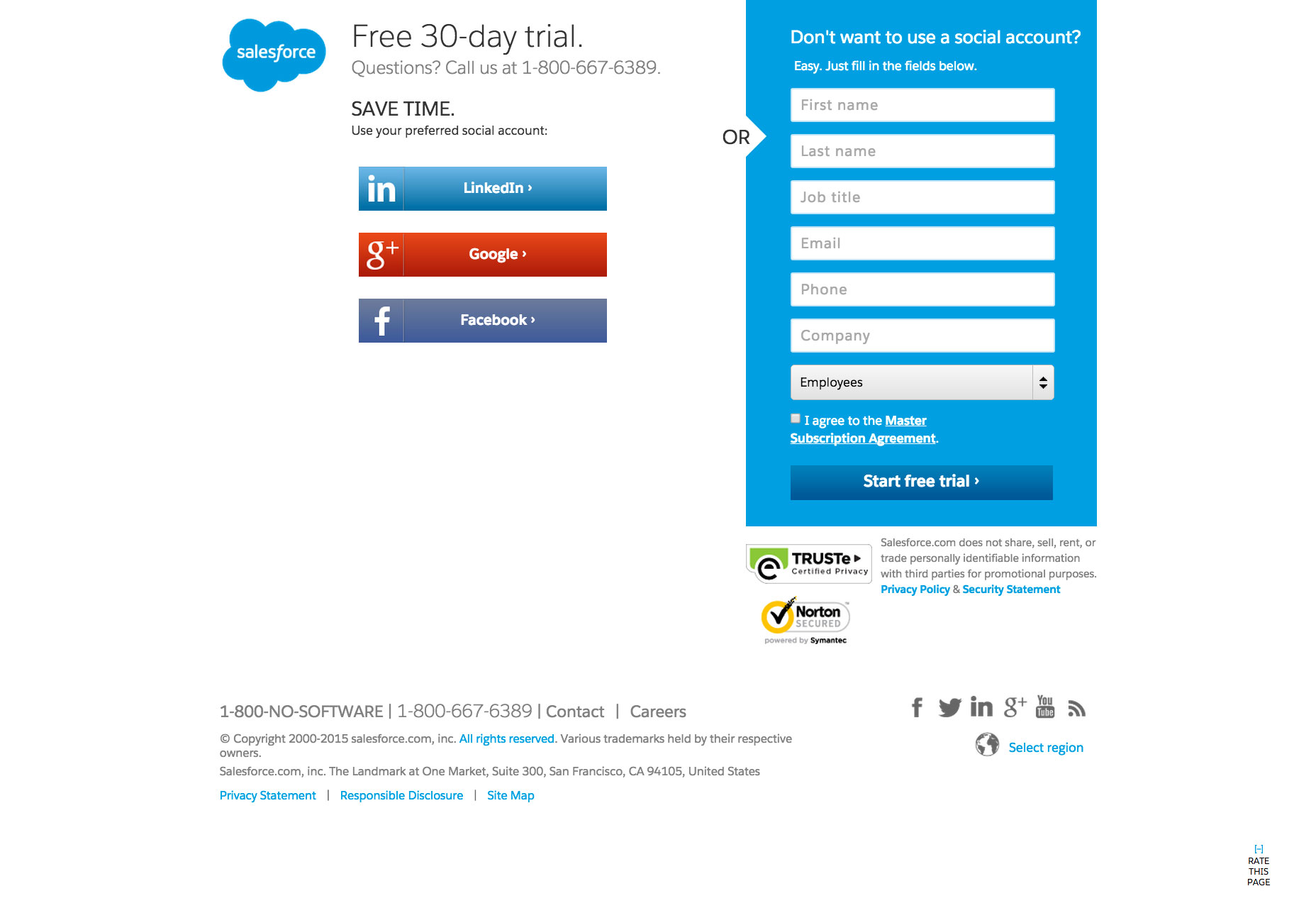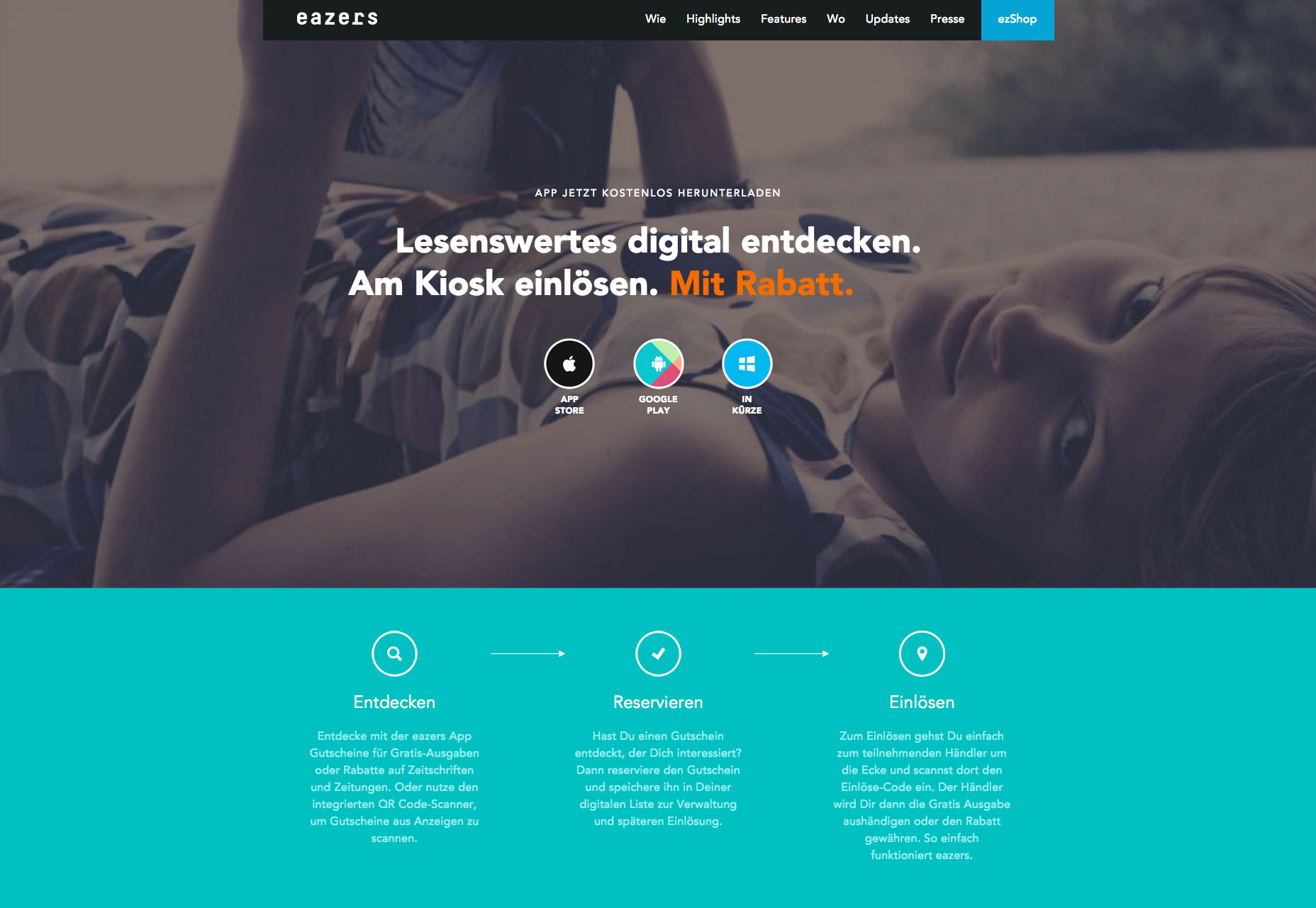
What are directional cues?
Directional cues come in all shapes and sizes, and you may even be surprised to learn what can pass as a directional cue. Furthermore, there are both explicit (very obvious) and implicit (more low-key) directional cues. Page elements that can be considered explicit directional cues include:- Arrows
- Fingers pointing
- Eye direction (when people’s faces are looking at a call to action)
- Lines
- Curves
 Here’s an ideal example of an explicit directional cue from Salesforce’s landing page. Note the use of the obvious arrow directing the user’s eye to the short web form.
Here’s an ideal example of an explicit directional cue from Salesforce’s landing page. Note the use of the obvious arrow directing the user’s eye to the short web form.
 Implicit directional cues are far easier to miss, and those elements that constitute an implicit directional cue are debatable, but they could include:
Implicit directional cues are far easier to miss, and those elements that constitute an implicit directional cue are debatable, but they could include:
- Color
- Repetition of size, color and shape
- Hierarchy

How do you clarify page goals?
Every page has a purpose, which is usually to get a visitor to buy, sign up for, or subscribe to something. When users don’t understand what the page’s purpose is—such as when the navigation is poorly implemented or the page is much too cluttered—the user experience will drastically decline. This is where a crystal clear directional cue can be the page’s lifesaver. After all, when the users receive cues on what they’re supposed to do on the page, then their experience drastically improves. Their confusion and frustration is replaced by a confidence and efficiency that are brought about by great organization, design and planning. Fittingly, a superb example of a directional cue comes to us on a page that talks about the definition of a directional cue. On Unbounce’s definition page, note the huge arrow pointing to the right and thereby prompting visitors to actually read the definition of a directional cue! Thanks to this simple page element, users can clearly understand that the goal of the page is to read and understand this definition.
Empowering users with directional cues
Visual Website Optimizer looked at a page displaying an ad for Sunsilk shampoo. The results were astounding: when the woman’s eyes in the ad actually looked to her right—at the bottle of shampoo, instead of into space—the number of users who finally looked at the bottle skyrocketed to 84%, from just a meager 6% when the original ad had the woman looking straight ahead. Eazers.com is a German site for coupons that effectively uses the same technique; the gaze of the model draws your eyes straight to the central calls to action. There’s no doubt that directional cues are very beneficial on a page, and it comes as no surprise, that the improved user experience provided by directional cues also naturally boosts the conversion rate on sites, as the two are interlinked. When the user experience of your site increases, people convert at higher rates because they understand what they’re supposed to do.
Users sometimes know exactly what they’re looking for when they visit your site. These are likely return visitors who want to use what they used the last time they were on your site. For these types of users, it’s paramount that your user experience is top-notch because the last thing you want to do is repel sure-bet conversions! One of the easiest ways to ensure a great user experience for a returning visitor who wants to use the same feature again is by providing a directional cue that’s easy to spot, interpret and then click on.
There’s no doubt that directional cues are very beneficial on a page, and it comes as no surprise, that the improved user experience provided by directional cues also naturally boosts the conversion rate on sites, as the two are interlinked. When the user experience of your site increases, people convert at higher rates because they understand what they’re supposed to do.
Users sometimes know exactly what they’re looking for when they visit your site. These are likely return visitors who want to use what they used the last time they were on your site. For these types of users, it’s paramount that your user experience is top-notch because the last thing you want to do is repel sure-bet conversions! One of the easiest ways to ensure a great user experience for a returning visitor who wants to use the same feature again is by providing a directional cue that’s easy to spot, interpret and then click on.
Don’t take directional cues for granted
The next time you’re designing and think of dismissing directional cues as just a bunch of unnecessary arrows, lines or curves, think again! Research has shown that they’re definitively tied into the user experience and, consequently, a page’s conversion rate. To help your site visitors experience a much better user experience—and your clients obtain a much better conversion rate—you’ve got to incorporate these directional cues into your design. More than issuing an instruction, directional cues are heavy-hints at what the user is expected to do. Some users won’t, some will, but the important thing is that they clearly understand what the ‘normal’ use of the page is. Directional cues are one of the best tools designers have for enhancing UX, and helping users to boost conversions for your client.Marc Schenker
Marc’s a copywriter who covers design news for Web Designer Depot. Find out more about him at thegloriouscompanyltd.com.
Read Next
3 Essential Design Trends, November 2024
Touchable texture, distinct grids, and two-column designs are some of the most trending website design elements of…
20 Best New Websites, October 2024
Something we’re seeing more and more of is the ‘customizable’ site. Most often, this means a button to swap between…
Exciting New Tools for Designers, October 2024
We’ve got goodies for designers, developers, SEO-ers, content managers, and those of you who wear multiple hats. And,…
15 Best New Fonts, September 2024
Welcome to our roundup of the best new fonts we’ve found on the web in the previous four weeks. In this month’s edition…
By Simon Sterne
3 Essential Design Trends, October 2024
This article is brought to you by Constantino, a renowned company offering premium and affordable website design
You…
A Beginner’s Guide to Using BlueSky for Business Success
In today’s fast-paced digital world, businesses are always on the lookout for new ways to connect with their audience.…
By Louise North
The Importance of Title Tags: Tips and Tricks to Optimize for SEO
When it comes to on-page SEO, there’s one element that plays a pivotal role in both search engine rankings and user…
By Simon Sterne
20 Best New Websites, September 2024
We have a mixed bag for you with both minimalist and maximalist designs, and single pagers alongside much bigger, but…
Exciting New Tools for Designers, September 2024
This time around we are aiming to simplify life, with some light and fast analytics, an all-in-one productivity…
3 Essential Design Trends, September 2024
September's web design trends have a fun, fall feeling ... and we love it. See what's trending in website design this…
Crafting Personalized Experiences with AI
Picture this: You open Netflix, and it’s like the platform just knows what you’re in the mood for. Or maybe you’re…
By Simon Sterne
15 Best New Fonts, August 2024
Welcome to August’s roundup of the best fonts we’ve found over the last few weeks. 2024’s trend for flowing curves and…
By Ben Moss















